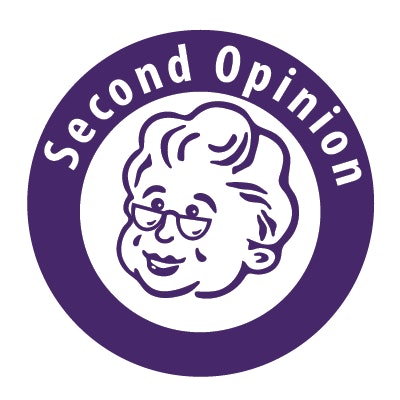
In ancient legend, the Greek army besieging Troy employed a ruse at the end of a decade-long war, constructing a giant wooden horse of surpassing beauty that was presented to the Trojans as a peace offering outside the city gates. The Trojans were warned to "beware of Greeks bearing gifts," but the admonition was ignored.
And so it was that, after the wooden horse was admitted into the city, concealed warriors crept out of the Trojan horse in the dead of night to open the city gates. Troy was sacked and burned, and its citizens slaughtered.
What does an ancient myth have to do with healthcare? The Trojan horse is a perfect metaphor for how the requirement of shared decision-making -- in which physicians and their patients decide together on a course of action -- has contributed to the disappointing uptake of CT lung cancer screening in the U.S.
This shortfall has led to the deaths of hundreds, if not thousands, of individuals whose disease could have been detected early and treated.
Early warning signs
Five years ago, AuntMinnie.com published two opinion pieces I wrote on the subject of population-based CT screening for lung cancer in high-risk individuals. The first, in May 2014, described my consternation at what I believed was a biased and injudicious decision by a panel of the Medicare Evidence Development and Coverage Advisory Committee (MEDCAC) to recommend against implementation of CT lung cancer screening of high-risk patients.
 Thoracic surgeon Dr. Frederic W. Grannis Jr.
Thoracic surgeon Dr. Frederic W. Grannis Jr.
The second, in November 2014, commented on a subsequent decision by the U.S. Centers for Medicare and Medicaid Services (CMS) to override MEDCAC and raised concern that the "most insidious mandate" in the CMS final opinion -- to require shared decision-making on screening between physicians and patients -- might represent a "poison pill" inserted into Medicare provisions with deliberate intent to delay and restrict uptake of lung cancer screening. I also expressed concern over use of decision aids.
"The main question here is regarding which decision-making tools are used. Some tools being promoted as meeting this requirement contain marked underestimates of survival and marked overestimates of harms," I wrote in November 2014. "If a patient is provided with such falsely low estimates of potential survival benefits and inaccurately high estimates of risks of screening, it can be confidently anticipated that he or she will probably opt against being screened. ... The cumulative result of all of these provisions in the CMS decision will be a marked reduction in the number of people at risk who will be screened."
In 2014, I also shared a concern that gratuitously inaccurate information on risks and benefits of lung cancer screening in decision aids for shared decision-making would be culled from a 2012 Annals of Internal Medicine article by Michael Gould and Peter Bach (both participants in the MEDCAC meeting).1
CMS did not endorse specific documents, but over the succeeding months, multiple decision aids were posted on the internet or printed in brochures. Almost all cloned inaccurate assessments of risk and benefit from Gould and Bach's 2012 data interpretations and stick-man graphics.
Warnings ignored
I have not been alone in my concerns about shared decision-making. Many others familiar with CT lung cancer screening shared this view. As in the case of Troy, our warnings were ignored -- but they have since been shown to be tragically accurate.
Two recent studies show dismally low uptake of lung cancer screening (rates of 2% to 4%) in the population at risk.2 3 One of them, an April 25 study by Huo et al in Cancer Epidemiology, Biomarkers, & Prevention, reported new data showing less than 9% of doctors talked about screening with current smokers.
Adding insult to injury, those who first advocated compulsory shared decision-making have now weighed in on low uptake of CT lung cancer screening. Bach recently wrote in an editorial published February 6, 2018, in Annals of Internal Medicine on what he calls "anemic" uptake of lung cancer screening.
"Perhaps providers and patients remain skeptical of the value of low-dose CT screening," Bach wrote.4
It is important to recall that it was Bach who advised MEDCAC against implementation of CT lung cancer screening. He also cautioned that if CMS chose to support screening, shared decision-making using defined decision aids should be required. The MEDCAC transcript clearly shows that he takes personal credit for the implementation of shared decision-making in lung cancer screening. "I'm very proud of that," he said.5
The effect of shared decision-making on lung screening uptake cannot be overstated. In an article published January 14, 2019, in JAMA Internal Medicine, Goodwin et al reported that few primary care physicians (10%) provide shared decision-making. When it was given, 40% of patients chose not to be screened.6
In an editorial published along with the study, Dr. Rita Redberg commented on this. Redberg, like Bach, has a long record of opposition to screening, and she chaired the 2014 MEDCAC session that advised against Medicare reimbursement.
"It is likely that patients' decisions not to undergo low-dose computed tomography for lung cancer screening are driven by the high false-positive rate, high chance of incidental findings and subsequent need for invasive procedures, and small chance of benefit," Redberg wrote.7
She went on to suggest that lung cancer screening be "reexamined" and "efforts refocused."
Misleading material
In my opinion, misleading material from the 2012 Gould-Bach article has been uncritically accepted by a wide spectrum of American primary care and pulmonary care physicians who are consequently reluctant to tell their patients to seek out CT lung cancer screening. As a further discouragement, a recommendation to a patient for screening puts physicians under the burden to take poorly compensated time from their busy practices to discuss a long list of complex "elements" that CMS requires.8
Currently available lung cancer screening decision aids
- American Thoracic Society
Decision Aid for Lung Cancer Screening with Computerized Tomography (CT) - Agency for Healthcare Research and Quality
- Is Lung Cancer Screening Right for Me? A decision aid for people considering lung cancer screening with low-dose computed tomography
- Is Lung Cancer Screening Right for Me? A decisionmaking tool for you and your health care professional
- Lung Cancer Screening: A summary guide for primary care clinicians
- Lung Cancer Screening: A Clinician's Checklist
- University of Michigan
Lung Cancer Screening: Should I get screened? - University of New Mexico Health System
Low Dose Computed Tomography Decision Aid - Robert Volk, PhD, University of Texas MD Anderson Cancer Center
Shared Decision Making for Lung Cancer Screening: Definitions, Models, and Strategies - Dr. Daniel Reuland et al, University of North Carolina at Chapel Hill, Preventing Overdiagnosis 2016
Effects of a lung cancer screening decision aid on overdiagnosis knowledge and screening intent in primary care patients
For patients, hearing that they have a four in five chance of dying even if lung cancer is diagnosed at an early stage by screening, and that screening would expose them to a substantial risk of adverse consequences, almost guarantees that many will opt against being screened.
Crothers reported in 2016 in the Annals of the American Thoracic Society, "Participants expressed surprise that the magnitude of their lung cancer risk and benefits of screening were lower than anticipated."9
But copious data clearly demonstrate that the information provided in current decision aids is markedly inaccurate. In the experience of the International Early Lung Cancer Action Program (I-ELCAP), a patient diagnosed with lung cancer by CT screening has an 80% chance of long-term survival.10 In the National Lung Screening Trial (NLST), patients diagnosed with CT had a 62% chance of five-year survival.11
Both the Dutch-Belgian Randomized Lung Cancer Screening (NELSON) and Multicentric Italian Lung Detection (MILD) randomized controlled trials on lung cancer screening have shown substantially better mortality reduction than NLST.12 13 Population screening of millions of Japanese patients uniformly demonstrates an excellent chance of cure.14 Follow-up publications from NLST investigators also provide documentation that risks of screening are much smaller than anticipated.15
Clinical practice guidelines, such as the I-ELCAP diagnostic algorithm and the National Comprehensive Cancer Network Lung Cancer Screening Guideline, offer substantially lower risk profiles than NLST -- which did not utilize a common diagnostic algorithm.
There exists minimal, if any, high-level evidence of the effectiveness of shared decision-making in medicine and even less information on its benefit in cancer screening. No other form of cancer screening bears the onus of shared decision-making or decision aids as lung screening does.
The misguided experiment with shared decision-making in CT lung screening has had tragic implications. Given the widely acknowledged ability of CT screening to safely detect early-stage lung cancer and allow curative treatment, shared decision-making may have contributed to the tragic deaths of many high-risk individuals who were either not offered screening or were provided with wrong information that led them to make bad decisions.
It is clear that current decision aids must be revised to provide accurate information. Would lung cancer screening uptake be higher if patient information correctly informed patients that their chance of long-term survival after lung cancer diagnosis by CT screening -- followed by prompt, guideline-specific treatment -- is four in five? The answer should be self-evident.
Further delay in implementing this process would inevitably cost more lives. Compulsory shared decision-making should not have been mandated in 2014, has shown itself to be counterproductive, and should now be rescinded. CMS must also reexamine the badly flawed policy process that first led to the implementation of shared decision-making.
Is shared decision-making a Trojan horse that was deployed with deliberate intent to delay and minimize the number of individuals participating in lung cancer screening programs?
If unreasonable barriers to screening are removed, and accurate information on benefits and risks is provided to primary care physicians and patients, I believe that uptake of screening will rapidly improve and that we can confidently expect a swift decline in lung cancer suffering and death in the U.S. during the next decade.
That is, unless warnings are ignored -- yet again.
References
- Bach PB, Gould MK. When the average applies to no one: Personalized decision making about potential benefits of lung cancer screening. Ann Intern Med. 2012;157(8):571-573.
- Jemal A, Fedewa SA. Lung cancer screening with low-dose computed tomography in the United States-2010 to 2015. JAMA Oncol. 2017;3(9):1278-1281.
- Huo J, Shen C, Volk RJ, Shih YT. Use of CT and chest radiography for lung cancer screening before and after publication of screening guidelines: Intended and unintended uptake. JAMA Intern Med. 2017;177(3):439-441.
- Green AK, Bach P. Model-based eligibility for lung cancer screening: Where theory meets practice. Ann Intern Med. 2018;168(3):223-224.
- MEDCAC meeting 4/30/2014 - Lung cancer screening with low dose computed tomography. Centers for Medicare & Medicaid Services website. https://www.cms.gov/medicare-coverage-database/details/medcac-meeting-details.aspx?medcacid=68. Accessed April 3, 2019.
- Goodwin JS, Nishi S, Zhou J, Kuo YF. Use of the shared decision-making visit for lung cancer screening among Medicare enrollees [published online ahead of print January 14, 2019]. JAMA Intern Med. https://jamanetwork.com/journals/jamainternalmedicine/article-abstract/2720126. Accessed May 8, 2019.
- Redberg RF. The case for implementing the Centers for Medicare & Medicaid Services' shared decision-making mandate: Where the rubber meets the code [published online ahead of print January 14, 2019]. JAMA Intern Med. https://jamanetwork.com/journals/jamainternalmedicine/article-abstract/2720122. Accessed May 8, 2019.
- Decision memo for screening for lung cancer with low dose computed tomography (LDCT) (CAG-00439N). Centers for Medicare & Medicaid Services website. https://www.cms.gov/medicare-coverage-database/details/nca-decision-memo.aspx?NCAId=274. Accessed April 3, 2019.
- Crothers K, Kross EK, Reisch LM, et al. Patients' attitudes regarding lung cancer screening and decision aids. A survey and focus group study. Ann Am Thorac Soc. 2016;13(11):1992-2001.
- International Early Lung Cancer Action Program Investigators, Henschke CI, Yankelevitz DF, et al. Survival of patients with stage I lung cancer detected on CT screening. N Engl J Med. 2006;355(17):1763-1771.
- Yip R, Henschke CI, Yankelevitz DF, Boffetta P, Smith JP, International Early Lung Cancer Investigators. The impact of the regimen of screening on lung cancer cure: A comparison of I-ELCAP and NLST. Eur J Cancer Prev. 2015;24(3):201-208.
- Goodman A. ASCO Post website. NELSON Trial: 'Call to Action' for Lung Cancer CT Screening of High-Risk Individuals. https://www.ascopost.com/issues/october-25-2018/nelson-trial/. October 25, 2018. Accessed April 26, 2019.
- Pastorino U, Silva M, Sestini S, et al. Prolonged Lung Cancer Screening Reduced 10-year Mortality in the MILD Trial [published online ahead of print April 1, 2019]. Ann Oncol. https://academic.oup.com/annonc/advance-article/doi/10.1093/annonc/mdz117/5425325. Accessed April 27, 2019.
- Sawabata N, Miyaoka E, Asamura H, et al. Japanese lung cancer registry study of 11,663 surgical cases in 2004: Demographic and prognosis changes over decade. J Thorac Oncol. 2011;6(7):1229-1235.
- de Koning HJ, Meza R, Plevritis SK, et al. Benefits and harms of computed tomography lung cancer screening strategies: A comparative modeling study for the U.S. Preventive Services Task Force. Ann Intern Med. 2014;160(5):311-320.
The comments and observations expressed herein are those of the author and do not necessarily reflect the opinions of AuntMinnie.com.




















